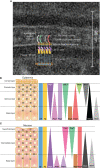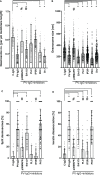Mechanisms Causing Acantholysis in Pemphigus-Lessons from Human Skin
- PMID: 35720332
- PMCID: PMC9205406
- DOI: 10.3389/fimmu.2022.884067
Mechanisms Causing Acantholysis in Pemphigus-Lessons from Human Skin
Abstract
Pemphigus vulgaris (PV) is an autoimmune bullous skin disease caused primarily by autoantibodies (PV-IgG) against the desmosomal adhesion proteins desmoglein (Dsg)1 and Dsg3. PV patient lesions are characterized by flaccid blisters and ultrastructurally by defined hallmarks including a reduction in desmosome number and size, formation of split desmosomes, as well as uncoupling of keratin filaments from desmosomes. The pathophysiology underlying the disease is known to involve several intracellular signaling pathways downstream of PV-IgG binding. Here, we summarize our studies in which we used transmission electron microscopy to characterize the roles of signaling pathways in the pathogenic effects of PV-IgG on desmosome ultrastructure in a human ex vivo skin model. Blister scores revealed inhibition of p38MAPK, ERK and PLC/Ca2+ to be protective in human epidermis. In contrast, inhibition of Src and PKC, which were shown to be protective in cell cultures and murine models, was not effective for human skin explants. The ultrastructural analysis revealed that for preventing skin blistering at least desmosome number (as modulated by ERK) or keratin filament insertion (as modulated by PLC/Ca2+) need to be ameliorated. Other pathways such as p38MAPK regulate desmosome number, size, and keratin insertion indicating that they control desmosome assembly and disassembly on different levels. Taken together, studies in human skin delineate target mechanisms for the treatment of pemphigus patients. In addition, ultrastructural analysis supports defining the specific role of a given signaling molecule in desmosome turnover at ultrastructural level.
Keywords: desmosomes; electron microscope; ex vivo skin model; pemphigus; signaling; ultrastructure.
Copyright © 2022 Egu, Schmitt and Waschke.
Conflict of interest statement
The authors declare that the research was conducted in the absence of any commercial or financial relationships that could be construed as a potential conflict of interest.
Figures



Similar articles
-
Electron microscopy reveals that phospholipase C and Ca2+ signaling regulate keratin filament uncoupling from desmosomes in Pemphigus.Ann Anat. 2022 Apr;241:151904. doi: 10.1016/j.aanat.2022.151904. Epub 2022 Feb 4. Ann Anat. 2022. PMID: 35131450
-
Inhibition of p38MAPK signalling prevents epidermal blistering and alterations of desmosome structure induced by pemphigus autoantibodies in human epidermis.Br J Dermatol. 2017 Dec;177(6):1612-1618. doi: 10.1111/bjd.15721. Epub 2017 Nov 14. Br J Dermatol. 2017. PMID: 28600798
-
A new ex vivo human oral mucosa model reveals that p38MAPK inhibition is not effective in preventing autoantibody-induced mucosal blistering in pemphigus.Br J Dermatol. 2020 Apr;182(4):987-994. doi: 10.1111/bjd.18237. Epub 2019 Sep 4. Br J Dermatol. 2020. PMID: 31218663
-
New insights into desmosome regulation and pemphigus blistering as a desmosome-remodeling disease.Kaohsiung J Med Sci. 2013 Jan;29(1):1-13. doi: 10.1016/j.kjms.2012.08.001. Epub 2012 Oct 12. Kaohsiung J Med Sci. 2013. PMID: 23257250 Free PMC article. Review.
-
150(th) anniversary series: Desmosomes and autoimmune disease, perspective of dynamic desmosome remodeling and its impairments in pemphigus.Cell Commun Adhes. 2014 Dec;21(6):269-80. doi: 10.3109/15419061.2014.943397. Epub 2014 Jul 31. Cell Commun Adhes. 2014. PMID: 25078507 Review.
Cited by
-
Catalytic antibodies in arrhythmogenic cardiomyopathy patients cleave desmoglein 2 and N-cadherin and impair cardiomyocyte cohesion.Cell Mol Life Sci. 2023 Jul 14;80(8):203. doi: 10.1007/s00018-023-04853-1. Cell Mol Life Sci. 2023. PMID: 37450050 Free PMC article.
-
Dsg3 epitope-specific signalling in pemphigus.Front Immunol. 2023 Apr 18;14:1163066. doi: 10.3389/fimmu.2023.1163066. eCollection 2023. Front Immunol. 2023. PMID: 37143675 Free PMC article.
-
Epac1 contributes to apremilast-mediated rescue of pemphigus autoantibody-induced loss of keratinocyte adhesion.JCI Insight. 2025 Apr 29;10(10):e187481. doi: 10.1172/jci.insight.187481. eCollection 2025 May 22. JCI Insight. 2025. PMID: 40299565 Free PMC article.
-
Measurement of pesticides in hair samples from pemphigus foliaceus and pemphigus vulgaris patients in Southeastern Brazil.An Bras Dermatol. 2023 Sep-Oct;98(5):644-650. doi: 10.1016/j.abd.2022.10.010. Epub 2023 May 17. An Bras Dermatol. 2023. PMID: 37208226 Free PMC article.
-
Unbiased screening identifies regulators of cell-cell adhesion and treatment options in pemphigus.Nat Commun. 2024 Sep 14;15(1):8044. doi: 10.1038/s41467-024-51747-2. Nat Commun. 2024. PMID: 39271654 Free PMC article.
References
Publication types
MeSH terms
Substances
LinkOut - more resources
Full Text Sources
Medical
Miscellaneous

